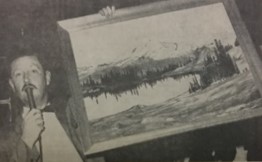I always picture him struggling with the oil painting as he made his way through the lobby of New York’s Biltmore Hotel. But the physician thought it important to bring a bit of home with him, a proxy for the actual wilderness he left behind. After all, he traveled all that way–from the flat-bottomed floor of Skagit Valley to the skyscrapered heights of Manhattan–to protest on the mountains’ behalf, to tell Kennecott Copper that the heart of Glacier Peak Wilderness Area was no place for a mine.
Fifty years ago, May 2, 1967, Dr. Fred T. Darvill stood up, spoke out, and walked tall. I’ve been following the links he left, the directions his story points from the region to the nation, past to present, his actions and ours.
Darvill lived in Mount Vernon, Washington, on the Skagit River, a stream whose tributaries included the Sauk whose tributaries included the Suiattle whose tributaries included Miners Creek whose waters flowed from Miners Ridge connecting the doctor, by way of wild waters under threat, to the open-pit mine Kennecott announced six months before.
The South Fork of the Sauk starts just over a ridge from the South Fork of the Stillaguamish, a river that joins other streams and tumbles out of the mountains, through the foothills, and along a valley floor five miles from my childhood home. We seem connected across time by watery proximities.
I found his letter to the local paper and another one to his U.S. Representative. But Darvill played for larger stages. With a knack for spectacle, Darvill purchased three shares of Kennecott stock, wrote the company president, and demanded to speak at the next stockholder meeting. And away he went to persuade Kennecott president Frank Milliken, members of the board, and fellow shareholders that the corporation’s interests lay in pulling out of the North Cascades to avoid a ruinous reputation.
“I have come here today to talk about wilderness and beauty.” Darvill’s opening line must have seemed unusual to the crowd accustomed to pronouncements of quarterly profits and recent acquisitions. My mind’s eye sees their quizzical looks and their barely muted hostility–crossed arms, wandering eyes, audible sighs–because I see such demeanors from certain audiences when I share how Darvill and like-minded citizens dared to challenge Copper.
The doctor continued, describing the forests and switchbacks a hiker encountered climbing to Miners Ridge and Image Lake beyond a watchful Glacier Peak. Arriving in the alpine meadows with panoramic views, hikers would “experience wilderness and . . . saturate themselves with beauty. To walk this ridge is an experience to be recalled for a lifetime. . . . Dozens of different species of wild flowers grow waist-high along the trail. Small streams plunge downward into the valley below.” Such descriptions, the glorious mountain scene, gave concrete examples to the board, other shareholders, and the public of the nature of Miners Ridge. The doctor’s portrayal helped transport listeners from the Biltmore to the Cascades and, with luck, from a boardroom mentality to a trailside reverence.
But Darvill decided words were not enough, and so he carried a painting with him depicting Image Lake, the iconic view in the North Cascades, the one the appeared in glossy magazines and knocked out your breath. As he was connected from home to ridge by rivers, here Darvill was linked in New York to the Cascades by art.

The doctor appeals to me. He endeavored to persuade and disrupt a system from within it and, I’d speculate, with a sense of humor. He shared what mattered, believing others might reconsider in the pause his presence provided. Much, I realize as I learn more and live more, depends on those pauses in history and life.
As his allotted time wound down in front of the board and other shareholders, Darvill tried to ridicule with doggerel: “Let it not be said, and said to your shame, that all was beauty here, until Kennecott Copper came.” He left the meeting “with the impression that this corporation strongly wants to go ahead with the mine, but,” he told the Seattle Times, “maybe what was done today will shake it up a bit.”
It did shake up the Washington Post, which published an editorial the next day, “Crisis at Miners Ridge.” The Post found no justification for “leaving a ghastly scar in the place of natural beauty,” a place the editors described as “one of the most alluring samples of the unspoiled manless world.” Darvill at least had persuaded the Post.
The Mount Vernon doctor crossed this stage populated by so many others, but his story–and pluck–stands out. Time and place connect us like water and paintings and anniversaries.